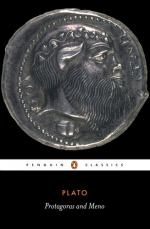|
This section contains 545 words (approx. 2 pages at 400 words per page) |

|
Section 4, Line 330-337 Summary and Analysis
Protagoras answers that these attributes of virtue are like the parts of a face. The eye, ear, mouth, and nose have separate functions, although they are all part of a face. Socrates objects to this analogy and asks is holiness, just? Likewise temperance and wisdom are similar qualities. Protagoras agrees that it is, so then the different parts of virtue are not separate and do resemble each other. Socrates compares this to opposite qualities that do not resemble each other, such as, fair and foul, and wisdom and folly.
One thing has only one opposite. Since folly is contrary to both wisdom and folly, which axioms of those in the dialogue to give up. Either they have to say that folly can be directly contrary to two distinct things, or they have to admit that wisdom and...
(read more from the Section 4, Line 330-337 Summary)
|
This section contains 545 words (approx. 2 pages at 400 words per page) |

|




